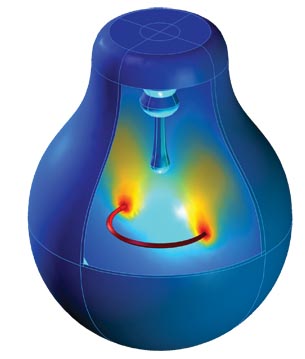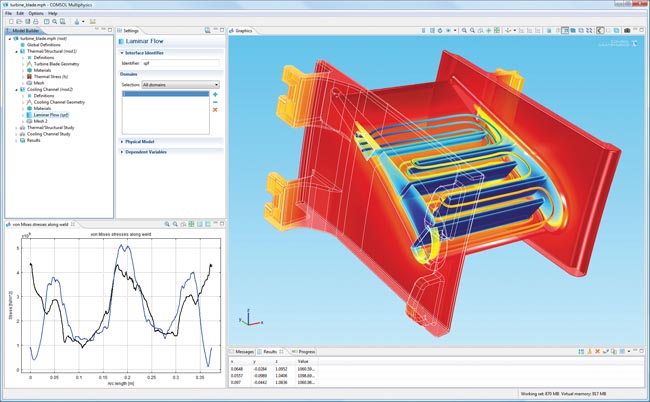April 1, 2011
By Vince Adams
 Multiphysics simulation of a light bulb using thermal, electric and CFD interactions. |
“It’s a multiphysics world,” says David Kan, vice president of sales, Southwest USA for COMSOL, Inc.
But what is multiphysics, and why do engineers need to embrace it?
Finite element analysis (FEA)-based simulation of single-physics problem simplifications, such as stress or fluid flow, has become accepted practice in most industries. This growth has been accelerated by the availability of integrated FEA tools in CAD and solid modeling products. While there are many cases where single physics simulations are still satisfactory, increasing pressure to create more realistic virtual prototypes to accelerate the design process and reduce cost requires a more all-encompassing approach.
The most common types of multiphysics, or multi-domain, problems being explored at the design level include:
- flexible bodies in multi-body dynamics (mechanism) simulations;
- fluid-structure interactions;
- chemical reactions coupled with fluid flow;
- resistive heating created by electric current flow; and
- thermal stress.
Multiphysics as a Design Tool
COMSOL Multiphysics has now linked its simulation tools to the design process. Version 4 represents a major revision to the interface and usability of the product. Improvements include the COMSOL Desktop featuring the Model Builder and the Live Link suite of products that integrate COMSOL multiphysics model to standard CAD packages.
COMSOL also augmented its existing Parasolid-based CAD Import Module with geometry import and export capabilities that can ease the migration to multiphysics for engineers. This was enhanced in Version 4.1 to include helical sweeps, parametric 2D and 3D curves, and geometry sweeps along 3D curves.
Dr. Darrell Pepper, interim dean, College of Engineering, University of Nevada, Las Vegas, says he believes the new interface will enable a new generation of engineers to innovate by making multiphysics accessible to students and design-level users.
“My students have developed revolutionary concepts, from inflatable wind turbines to solar-powered aircraft,” he says.
 The design analysis of a turbine stator blade calculates its thermal stress using the all-new COMSOL Desktop in COMSOL Multiphysics Version 4. |
The LiveLink suite of products, introduced in Version 4, establishes an associative connection between COMSOL and the solid modeling of CAD tools such as Creo Elements/Pro, Autodesk Inventor and SolidWorks. A change of a feature in the CAD model automatically updates the geometry in COMSOL Multiphysics, while retaining physics settings. Geometric parameters defined in CAD can be linked to the user’s simulation geometry. This enables multiphysics simulation involving parametric sweeps and design optimization directly from within the CAD program.
Material properties can now be conveniently linked to geometry in Version 4, set once for the entire model. The materials library in COMSOL includes more than 2,500 entries, many with non-linear and temperature-dependent properties. Users can define their own materials or update existing library materials to better suit their needs.
New Desktop Environment
For current users, the most striking difference in COMSOL Version 4 is the new desktop environment. Many productivity-enhancing features have been incorporated into this new interface that will benefit veteran and new users alike.
A feature-tree structure, called the Model Builder, now captures model structure and simulation workflow in addition to properties and settings. COMSOL has introduced Sequences, which are feature tree objects that represent steps in a solution or project. These can be re-ordered, activated independently or copied for repetitive tasks. Solver sequence objects allow users to easily declare the results of one study as the initial conditions of a subsequent one.
Version 4.1 expands the Copy/Paste functionality, which will allow users to rapidly build complex sequences with minimal duplication of effort. Undo/Redo was also added in version 4.1.
Users can also access multiple solutions or iterations from the Model Builder tree for quick visualization and comparison. These comparisons can also be incorporated into detailed reports using the enhanced auto-report generation feature.
Another important feature of the new Desktop is window manipulation. Windows or menus can be docked or undocked for user-customizable screen organization. Wide-format monitor support has been added, and windows can be detached from the primary desktop for efficient use of multiple monitors.
Up to the Challenge
Pre-defined multi-physics combinations can be easily accessed using the Model Wizard, so there are few limitations on the problem complexity one can construct. COMSOL now offers vertical applications using the multiphysics engine for more full-featured computational fluid dynamics (CFD), plasma modeling, and batteries and fuel cells. These can incorporate interactions among chemical, electro-magnetic and fluid flow responses.
Version 4.1 provides a revamped interface for modeling lead acid batteries, and has added a Spalart-Allmaras turbulence model to the CFD module.
Finite Element meshing is a key part of any COMSOL multiphysics project. The Live Link suite of products and parametric-associativity to geometry in COMSOL Version 4 has made this task manageable and controllable for a design environment. This was enhanced in version 4.1 to provide physics-based meshing. Because the meshing needs of a stress solution are different than a CFD study, for example, analysts working in multiphysics have had to balance solution accuracy with modeling efficiency at this stage of problem set-up. Now, in CFD and plasma physics solutions, the software will adjust the mesh to the requirements of the problem automatically.
For effective completion of complex models, COMSOL has added the ability to post-process, or view calculated data, during the actual solution so problem set-up or assumption errors are more easily detected without having to wait out a lengthy completion. In version 4.1, the actual equations being solved are displayed so that users have an additional level of confidence in the process. Results from multiple solutions can be viewed at the same time. Polar plots and the ability to switch time-based solution data to the frequency domain for outputs such as fast Fourier transforms (FFTs) were added in version 4.1.
High-performance computing (HPC) is available with a floating license of COMSOL. This is important to users who build larger models with a variety of physical interactions. To simplify access to this feature, there are no pay-per-core or other model-size related charges. Termed “All Inclusive” by COMSOL, a floating license enables customers to solve a single problem on clusters, with no limit on the number of nodes. Clusters are supported on Linux or Windows HPC Server 2008.
“Customers with a floating network license of COMSOL can run a simulation on any number of nodes for cluster computing at no additional COMSOL licensing fee,” explains Bernt Nilsson, COMSOL’s senior vice president of marketing. “This distinguishes COMSOL Multiphysics from other developers of simulation software who price their applications proportional to the number of computers and processors available to the user.”
Another Version 4.1 feature that has a direct impact on large-model users is the auto-recovery option. The longer the run, the greater the chance that hardware problems such as server or desktop crashes—even power failures—will render hours of run-time useless. COMSOL version 4.1 now saves restart data regularly so in the event of such a failure, the model can be continued practically from the point of stoppage. A related Version 4.1 feature is the ability to Pause and Restart a job, either in anticipation of a computing problem or simply to interrupt the long solve for something more urgent.
COMSOL reports a user-base of more than 60,000 users worldwide.
More Info:
COMSOL Multiphysics
Siemens
Vince Adams, currently an account manager for LMS, is a longtime simulation educator, consultant and speaker. He has authored three books on finite element analysis and numerous magazine articles. Contact him via [email protected].
Subscribe to our FREE magazine, FREE email newsletters or both!
About the Author
DE’s editors contribute news and new product announcements to Digital Engineering.
Press releases may be sent to them via [email protected].






